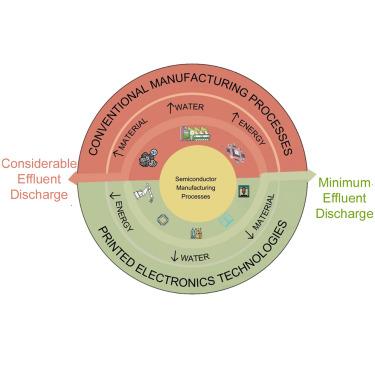Semiconductor manufacturing wastewater challenges and the potential solutions via printed electronics
IF 4.1
2区 综合性期刊
Q1 MULTIDISCIPLINARY SCIENCES
引用次数: 0
Abstract
The rapid expansion of the semiconductor industry has not only accelerated global digital transformation but also brought serious environmental concerns, particularly through the discharge of hazardous, toxic, and persistent wastewater. Traditional semiconductor manufacturing is highly water and energy intensive, relying on critical and often toxic materials—many with proprietary or unknown chemical compositions. This review outlines the environmental impact of semiconductor wastewater, highlighting key contaminants and chemicals used in the process. Due to the complexity and sometimes the opacity of wastewater composition, current treatment technologies face significant limitations. The article also explores the potential for reducing environmental harm by transitioning toward minimal liquid discharge systems. In particular, it highlights alternative technologies such as printed electronics, which offer a promising path forward by minimizing the use of toxic chemicals, reducing energy consumption, and significantly lowering wastewater output. These strategies represent a realistic and necessary shift toward more sustainable semiconductor manufacturing practices.

半导体制造废水的挑战和通过印刷电子的潜在解决方案
半导体产业的快速发展不仅加速了全球数字化转型,也带来了严重的环境问题,特别是通过排放有害、有毒和持久性废水。传统的半导体制造是高度水和能源密集型的,依赖于关键且往往有毒的材料,其中许多具有专有或未知的化学成分。本文概述了半导体废水对环境的影响,重点介绍了该过程中使用的主要污染物和化学物质。由于废水成分的复杂性和不透明性,目前的处理技术面临着很大的局限性。文章还探讨了通过向最小液体排放系统过渡来减少环境危害的潜力。它特别强调了印刷电子等替代技术,这些技术通过最大限度地减少有毒化学品的使用、减少能源消耗和显著降低废水排放量,提供了一条有前途的发展道路。这些战略代表了向更可持续的半导体制造实践的现实和必要的转变。
本文章由计算机程序翻译,如有差异,请以英文原文为准。
求助全文
约1分钟内获得全文
求助全文
来源期刊

iScience
Multidisciplinary-Multidisciplinary
CiteScore
7.20
自引率
1.70%
发文量
1972
审稿时长
6 weeks
期刊介绍:
Science has many big remaining questions. To address them, we will need to work collaboratively and across disciplines. The goal of iScience is to help fuel that type of interdisciplinary thinking. iScience is a new open-access journal from Cell Press that provides a platform for original research in the life, physical, and earth sciences. The primary criterion for publication in iScience is a significant contribution to a relevant field combined with robust results and underlying methodology. The advances appearing in iScience include both fundamental and applied investigations across this interdisciplinary range of topic areas. To support transparency in scientific investigation, we are happy to consider replication studies and papers that describe negative results.
We know you want your work to be published quickly and to be widely visible within your community and beyond. With the strong international reputation of Cell Press behind it, publication in iScience will help your work garner the attention and recognition it merits. Like all Cell Press journals, iScience prioritizes rapid publication. Our editorial team pays special attention to high-quality author service and to efficient, clear-cut decisions based on the information available within the manuscript. iScience taps into the expertise across Cell Press journals and selected partners to inform our editorial decisions and help publish your science in a timely and seamless way.
 求助内容:
求助内容: 应助结果提醒方式:
应助结果提醒方式:


